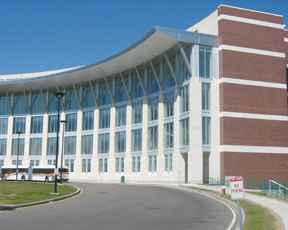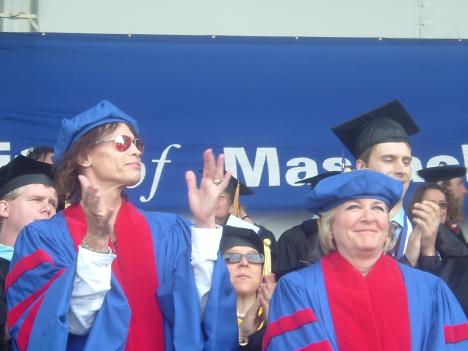UMB Undergoes NEASC Evaluation

Every 10 years New England Schools are evaluated by the New England Schools are evaluated by the New England Association of Schools and Colleges (NEASC).
April 21, 2005
By Nancy DerbyStaff Writer
Every 10 years all schools in New England, from preschools to doctoral programs, undergo scheduled mandatory evaluations by the New England Association of Schools and Colleges (NEASC). Last week, from April 17-20, NEASC evaluators made their decentennial visit to UMass Boston and met with faculty, staff, administrators, and students to assess the strengths and weaknesses of the university.
In preparation for this visit, UMB conducted an internal Reaccredidation Self-Study Report, completed in February 2005, that outlined three areas on which the outside review team should focus: improving the university’s physical infrastructure, rebuilding faculty, and stabilizing student enrollment. This 120-page self-study further divides the three areas into an additional 11 fields (called standards) and provides a comprehensive guide for the evaluators to follow and base their final judgments.
The Process
The self-study contains the institution’s mission, organization, background, strengths, areas for improvement, and methods in place to bring about improvements. The evaluators read the self-study as well as the previous NEASC evaluation from 10 years prior to learn as much about the institution NEASC selected them to review before visiting the site, and in ideal circumstances the visit simply confirms the content of the self-study.
According to Peter Langer, associate provost at UMB and co-chair of the self-accreditation committee, “There will be no major surprises,” for the university. “We wrote an honest and candid report, which means the university has a strong self-evaluation process.”
Michael Schwartz, president of Cleveland State University and team chair of the NEASC committee, said, “the self-study was an unusually helpful guide and that is was extremely well done” during the NEASC Exit Presentation, the forum where the evaluators address their observations to the campus community.
In the case of an obvious area of concern, such as the university’s megastructure, or upper and lower level infrastructure, more commonly known as the parking garage, evaluators judge the university’s ability to provide a coherent future solution. The self-study states, “The University of Massachusetts Boston has made significant improvements in physical resources since the last NEASC Report in 1995, but we are still faced with major problems which must be addressed within ten years to allow the continued full use of our buildings.”
Since 1995 UMass Boston replaced expansion joints and repaired beams in the parking garage to temporarily offset inevitable long-term collapse, and Langer adds that the infrastructure “must be one of the UMass’ top priorities. We are working with DECAM (Division of Capital Asset Management), a state agency that takes care of capital building projects, to fix this problem. It’s a front burner for the entire UMass system, not just UMass Boston.”
Vice President for Finance Jay. V. Kahn of Keene State College in New Hampshire, overseer of Standard Eight: Physical Resources, has the task of assessing whether or not the university is adequately confronting the university’s problematic infrastructure, but Standard Eight is not confined to the parking garage.
Improvements such as the opening of the Campus Center, five major roof repairs, brick replacement on Healey Library, internet access in all classrooms, and physical improvements to laboratories and classrooms over three years are also considered in Standard Eight.
The final decision for the university’s accreditation follows a basic pass/fail path. Each standard is evaluated individually, but the university receives a holistic grade weighing all areas.
The Results
During the Exit Presentation, which took place April 13 in the Campus Center Ballroom, the reviewers presented their opinions to the attentive audience or about 90 faculty, students, and staff.
Praise for the university included a clearly stated and input-driven mission statement from Schwartz and a positive re-assessment and improvement in the general education requirement through the Academic Quality Assessment and Development (AQUAD) program from Douglas Gelinas, associate vice president at the University of Maine and evaluator of Planning and Evaluation.
Repeated concern included department’s reliance on part-time and non-tenure track instructors from Lynn Pasquerella, the team member focusing on Faculty and associate dean of the University of Rhode Island’s graduate school, and Bruce Mallory, the team member focusing on Programs and Instruction and provost and executive vice president of Academic Affairs at the University of New Hampshire.
Also repeated concern for evaluating student outcomes in Standard Two (Planning and Evaluation) and Standard Four (Programs and Instruction) were raised. For Standard Two, the report stated that “An area of concern is that there is little progress in developimg learning outcomes for students in the arts and sciences.” The report further criticized the university’s lack of non-academic planning and evaluation, such as marketing and demographic research upon which to form “enrollment strategies and housing plans.” In relation to issues centered around Standard Four, the report stressed concerns on the obvious dearth of tenured faculty and staff, and the resulting increase of responsibility on the present tenured few, as the university has been relying more and more on hiring part-time faculty. Concerns about graduate student financial aid, laboratory and library resources, research infrastructure, and grad school retention and enrollment were also raised. On the flip side, our programs meet NEASC’s, and UMB’s own, standards of quality.
Selecting a Team of NEASC Reviewers
NEASC certifies and chooses a group of individuals from similar, but not competitive, institutions in New England. In UMass Boston’s case, this means a public, urban, four-year university offering undergraduate and graduate degrees not located in Massachusetts. However, because there are few public urban universities in New England, this year’s accreditation process also recruited evaluators from the University of Texas at San Antonio; University of Illinois, Chicago; and Cleveland State University. The UMass Boston team is composed of nine evaluators, including a team chair who oversees the process, judges the evaluators competency, and takes on the Mission and Purposes standard. Of the additional 10 standards, one to two individuals, selected because of their similar expertise from their respective university or college, evaluate each area, with one to two secondary reviewers selected for additional area examination.
About NEASC
Founded in 1885, NEASC serves some 1,890 public and independent schools, colleges and universities in the six states of Connecticut, Maine, Massachusetts, New Hampshire, Rhode Island and Vermont and 129 American/International schools around the globe. UMass Boston is one of 250 degree-granting post-secondary institutions in New England accredited by NEASC.





















































